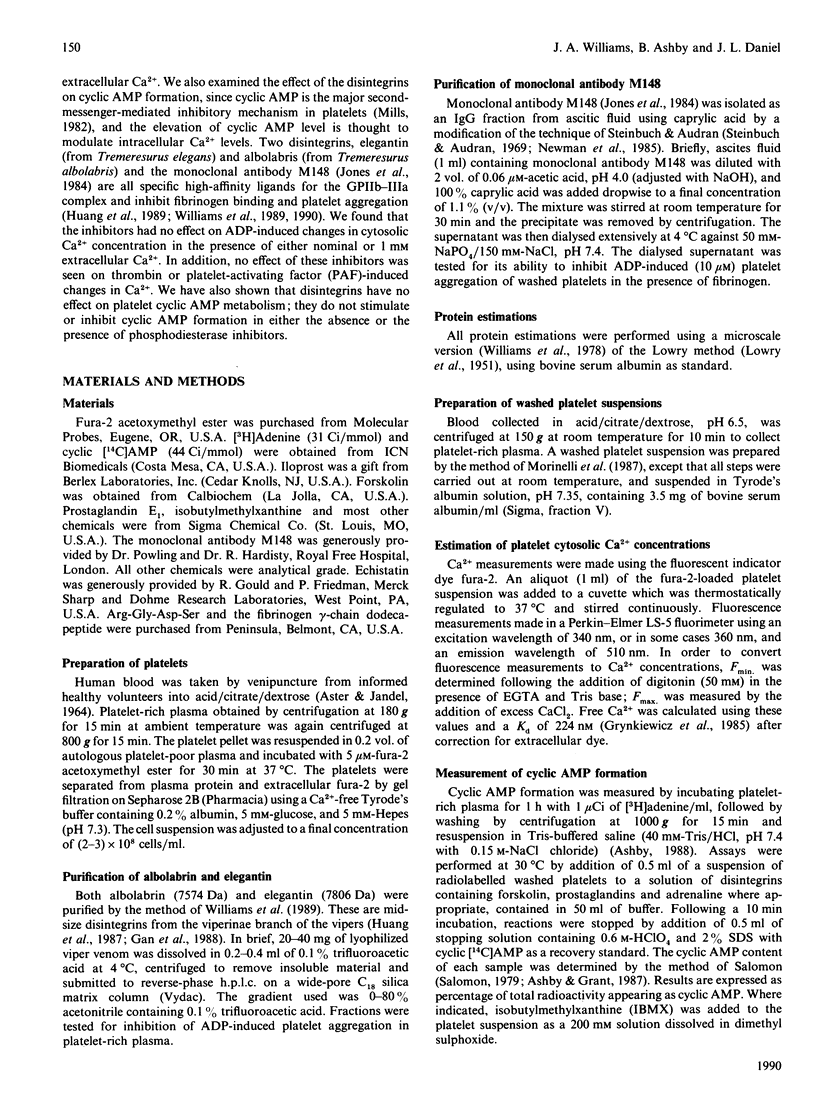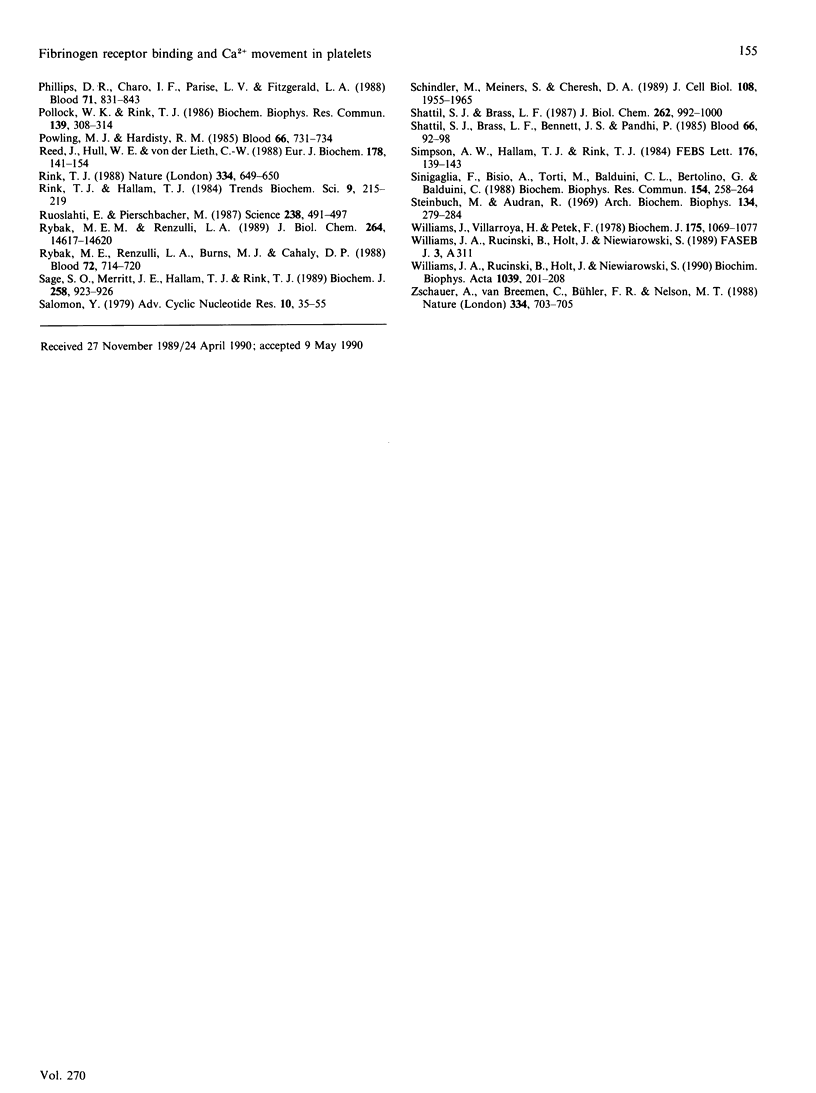Abstract
Previous studies have suggested that the platelet glycoprotein complex GPIIb-IIIa, which is the putative fibrinogen receptor, regulates Ca2+ influx into platelets, possibly operating as a Ca2+ channel. We have used RGD-peptides (peptides containing the sequence Arg-Gly-Asp; disintegrins), isolated from snake venoms, that have a high affinity and specificity for the fibrinogen-binding site of GPIIb-IIIa to address the question of whether blocking this site inhibits Ca2+ movement from the extracellular medium to the cytosol. Using fura-2-loaded human platelets, we found that neither disintegrins nor a monoclonal antibody (M148) to the GPIIb-IIIa complex altered the level of cytosolic Ca2+ obtained when the cells were stimulated with various agonists in the presence of either nominal or 1 mM extracellular Ca2+. In the presence of Mn2+, an ion that quenches fura-2 fluorescence, fura-2-loaded platelets were stimulated with thrombin or ADP. Neither disintegrins nor the monoclonal antibody altered the kinetics or the amount of quenching of fura-2 fluorescence by Mn2+. These data indicate that the binding of ligands to the fibrinogen receptor is not associated with an inhibition of Ca2+ movement through a receptor-operated channel. Furthermore, the disintegrins have no effect on platelet cyclic AMP metabolism in either the presence or the absence of phosphodiesterase inhibitors.
Full text
PDF






Selected References
These references are in PubMed. This may not be the complete list of references from this article.
- ASTER R. H., JANDL J. H. PLATELET SEQUESTRATION IN MAN. I. METHODS. J Clin Invest. 1964 May;43:843–855. doi: 10.1172/JCI104970. [DOI] [PMC free article] [PubMed] [Google Scholar]
- Ashby B. Cyclic AMP turnover in response to prostaglandins in intact platelets: evidence for separate stimulatory and inhibitory prostaglandin receptors. Second Messengers Phosphoproteins. 1988;12(1):45–57. [PubMed] [Google Scholar]
- Banga H. S., Simons E. R., Brass L. F., Rittenhouse S. E. Activation of phospholipases A and C in human platelets exposed to epinephrine: role of glycoproteins IIb/IIIa and dual role of epinephrine. Proc Natl Acad Sci U S A. 1986 Dec;83(23):9197–9201. doi: 10.1073/pnas.83.23.9197. [DOI] [PMC free article] [PubMed] [Google Scholar]
- Brass L. F. Ca2+ homeostasis in unstimulated platelets. J Biol Chem. 1984 Oct 25;259(20):12563–12570. [PubMed] [Google Scholar]
- Brass L. F. Ca2+ transport across the platelet plasma membrane. A role for membrane glycoproteins IIB and IIIA. J Biol Chem. 1985 Feb 25;260(4):2231–2236. [PubMed] [Google Scholar]
- Catterall W. A. Structure and function of voltage-sensitive ion channels. Science. 1988 Oct 7;242(4875):50–61. doi: 10.1126/science.2459775. [DOI] [PubMed] [Google Scholar]
- Doyle V. M., Rüegg U. T. Lack of evidence for voltage dependent calcium channels on platelets. Biochem Biophys Res Commun. 1985 Feb 28;127(1):161–167. doi: 10.1016/s0006-291x(85)80139-x. [DOI] [PubMed] [Google Scholar]
- Feinstein M. B., Egan J. J., Sha'afi R. I., White J. The cytoplasmic concentration of free calcium in platelets is controlled by stimulators of cyclic AMP production (PGD2, PGE1, forskolin). Biochem Biophys Res Commun. 1983 Jun 15;113(2):598–604. doi: 10.1016/0006-291x(83)91768-0. [DOI] [PubMed] [Google Scholar]
- Fitzgerald L. A., Steiner B., Rall S. C., Jr, Lo S. S., Phillips D. R. Protein sequence of endothelial glycoprotein IIIa derived from a cDNA clone. Identity with platelet glycoprotein IIIa and similarity to "integrin". J Biol Chem. 1987 Mar 25;262(9):3936–3939. [PubMed] [Google Scholar]
- Fujimura K., Phillips D. R. Calcium cation regulation of glycoprotein IIb-IIIa complex formation in platelet plasma membranes. J Biol Chem. 1983 Sep 10;258(17):10247–10252. [PubMed] [Google Scholar]
- Gan Z. R., Gould R. J., Jacobs J. W., Friedman P. A., Polokoff M. A. Echistatin. A potent platelet aggregation inhibitor from the venom of the viper, Echis carinatus. J Biol Chem. 1988 Dec 25;263(36):19827–19832. [PubMed] [Google Scholar]
- Grynkiewicz G., Poenie M., Tsien R. Y. A new generation of Ca2+ indicators with greatly improved fluorescence properties. J Biol Chem. 1985 Mar 25;260(6):3440–3450. [PubMed] [Google Scholar]
- Hallam T. J., Rink T. J. Agonists stimulate divalent cation channels in the plasma membrane of human platelets. FEBS Lett. 1985 Jul 8;186(2):175–179. doi: 10.1016/0014-5793(85)80703-1. [DOI] [PubMed] [Google Scholar]
- Hallam T. J., Rink T. J. Responses to adenosine diphosphate in human platelets loaded with the fluorescent calcium indicator quin2. J Physiol. 1985 Nov;368:131–146. doi: 10.1113/jphysiol.1985.sp015850. [DOI] [PMC free article] [PubMed] [Google Scholar]
- Hallam T. J., Sanchez A., Rink T. J. Stimulus-response coupling in human platelets. Changes evoked by platelet-activating factor in cytoplasmic free calcium monitored with the fluorescent calcium indicator quin2. Biochem J. 1984 Mar 15;218(3):819–827. doi: 10.1042/bj2180819. [DOI] [PMC free article] [PubMed] [Google Scholar]
- Hallam T. J., Thompson N. T., Scrutton M. C., Rink T. J. The role of cytoplasmic free calcium in the responses of quin2-loaded human platelets to vasopressin. Biochem J. 1984 Aug 1;221(3):897–901. doi: 10.1042/bj2210897. [DOI] [PMC free article] [PubMed] [Google Scholar]
- Huang T. F., Holt J. C., Kirby E. P., Niewiarowski S. Trigramin: primary structure and its inhibition of von Willebrand factor binding to glycoprotein IIb/IIIa complex on human platelets. Biochemistry. 1989 Jan 24;28(2):661–666. doi: 10.1021/bi00428a037. [DOI] [PubMed] [Google Scholar]
- Huang T. F., Holt J. C., Lukasiewicz H., Niewiarowski S. Trigramin. A low molecular weight peptide inhibiting fibrinogen interaction with platelet receptors expressed on glycoprotein IIb-IIIa complex. J Biol Chem. 1987 Nov 25;262(33):16157–16163. [PubMed] [Google Scholar]
- Jones D., Fritschy J., Garson J., Nokes T. J., Kemshead J. T., Hardisty R. M. A monoclonal antibody binding to human medulloblastoma cells and to the platelet glycoprotein IIB-IIIA complex. Br J Haematol. 1984 Aug;57(4):621–631. doi: 10.1111/j.1365-2141.1984.tb02939.x. [DOI] [PubMed] [Google Scholar]
- Käser-Glanzmann R., Gerber E., Lüscher E. F. Regulation of the intracellular calcium level in human blood platelets: cyclic adenosine 3',5'-monophosphate dependent phosphorylation of a 22,000 dalton component in isolated Ca2+-accumulating vesicles. Biochim Biophys Acta. 1979 Dec 12;558(3):344–347. doi: 10.1016/0005-2736(79)90271-2. [DOI] [PubMed] [Google Scholar]
- LOWRY O. H., ROSEBROUGH N. J., FARR A. L., RANDALL R. J. Protein measurement with the Folin phenol reagent. J Biol Chem. 1951 Nov;193(1):265–275. [PubMed] [Google Scholar]
- Morinelli T. A., Niewiarowski S., Daniel J. L., Smith J. B. Receptor-mediated effects of a PGH2 analogue (U 46619) on human platelets. Am J Physiol. 1987 Nov;253(5 Pt 2):H1035–H1043. doi: 10.1152/ajpheart.1987.253.5.H1035. [DOI] [PubMed] [Google Scholar]
- Newman P. J., Allen R. W., Kahn R. A., Kunicki T. J. Quantitation of membrane glycoprotein IIIa on intact human platelets using the monoclonal antibody, AP-3. Blood. 1985 Jan;65(1):227–232. [PubMed] [Google Scholar]
- Phillips D. R., Baughan A. K. Fibrinogen binding to human platelet plasma membranes. Identification of two steps requiring divalent cations. J Biol Chem. 1983 Sep 10;258(17):10240–10246. [PubMed] [Google Scholar]
- Phillips D. R., Charo I. F., Parise L. V., Fitzgerald L. A. The platelet membrane glycoprotein IIb-IIIa complex. Blood. 1988 Apr;71(4):831–843. [PubMed] [Google Scholar]
- Phillips D. R., Jennings L. K., Edwards H. H. Identification of membrane proteins mediating the interaction of human platelets. J Cell Biol. 1980 Jul;86(1):77–86. doi: 10.1083/jcb.86.1.77. [DOI] [PMC free article] [PubMed] [Google Scholar]
- Pollock W. K., Rink T. J. Thrombin and ionomycin can raise platelet cytosolic Ca2+ to micromolar levels by discharge of internal Ca2+ stores: studies using fura-2. Biochem Biophys Res Commun. 1986 Aug 29;139(1):308–314. doi: 10.1016/s0006-291x(86)80114-0. [DOI] [PubMed] [Google Scholar]
- Powling M. J., Hardisty R. M. Glycoprotein IIb-IIIa complex and Ca2+ influx into stimulated platelets. Blood. 1985 Sep;66(3):731–734. [PubMed] [Google Scholar]
- Reed J., Hull W. E., von der Lieth C. W., Kübler D., Suhai S., Kinzel V. Secondary structure of the Arg-Gly-Asp recognition site in proteins involved in cell-surface adhesion. Evidence for the occurrence of nested beta-bends in the model hexapeptide GRGDSP. Eur J Biochem. 1988 Dec 1;178(1):141–154. doi: 10.1111/j.1432-1033.1988.tb14439.x. [DOI] [PubMed] [Google Scholar]
- Rink T. J. A real receptor-operated calcium channel? Nature. 1988 Aug 25;334(6184):649–650. doi: 10.1038/334649a0. [DOI] [PubMed] [Google Scholar]
- Ruoslahti E., Pierschbacher M. D. New perspectives in cell adhesion: RGD and integrins. Science. 1987 Oct 23;238(4826):491–497. doi: 10.1126/science.2821619. [DOI] [PubMed] [Google Scholar]
- Rybak M. E., Renzulli L. A., Bruns M. J., Cahaly D. P. Platelet glycoproteins IIb and IIIa as a calcium channel in liposomes. Blood. 1988 Aug;72(2):714–720. [PubMed] [Google Scholar]
- Rybak M. E., Renzulli L. A. Ligand inhibition of the platelet glycoprotein IIb-IIIa complex function as a calcium channel in liposomes. J Biol Chem. 1989 Sep 5;264(25):14617–14620. [PubMed] [Google Scholar]
- Sage S. O., Merritt J. E., Hallam T. J., Rink T. J. Receptor-mediated calcium entry in fura-2-loaded human platelets stimulated with ADP and thrombin. Dual-wavelengths studies with Mn2+. Biochem J. 1989 Mar 15;258(3):923–926. doi: 10.1042/bj2580923. [DOI] [PMC free article] [PubMed] [Google Scholar]
- Salomon Y. Adenylate cyclase assay. Adv Cyclic Nucleotide Res. 1979;10:35–55. [PubMed] [Google Scholar]
- Schindler M., Meiners S., Cheresh D. A. RGD-dependent linkage between plant cell wall and plasma membrane: consequences for growth. J Cell Biol. 1989 May;108(5):1955–1965. doi: 10.1083/jcb.108.5.1955. [DOI] [PMC free article] [PubMed] [Google Scholar]
- Shattil S. J., Brass L. F., Bennett J. S., Pandhi P. Biochemical and functional consequences of dissociation of the platelet membrane glycoprotein IIb-IIIa complex. Blood. 1985 Jul;66(1):92–98. [PubMed] [Google Scholar]
- Shattil S. J., Brass L. F. Induction of the fibrinogen receptor on human platelets by intracellular mediators. J Biol Chem. 1987 Jan 25;262(3):992–1000. [PubMed] [Google Scholar]
- Simpson A. W., Hallam T. J., Rink T. J. TMB-8 inhibits secretion evoked by phorbol ester at basal cytoplasmic free calcium in quin2-loaded platelets much more effectively than it inhibits thrombin-induced calcium mobilisation. FEBS Lett. 1984 Oct 15;176(1):139–143. doi: 10.1016/0014-5793(84)80928-x. [DOI] [PubMed] [Google Scholar]
- Sinigaglia F., Bisio A., Torti M., Balduini C. L., Bertolino G., Balduini C. Effect of GPIIb-IIIa complex ligands on calcium ion movement and cytoskeleton organization in activated platelets. Biochem Biophys Res Commun. 1988 Jul 15;154(1):258–264. doi: 10.1016/0006-291x(88)90678-x. [DOI] [PubMed] [Google Scholar]
- Steinbuch M., Audran R. The isolation of IgG from mammalian sera with the aid of caprylic acid. Arch Biochem Biophys. 1969 Nov;134(2):279–284. doi: 10.1016/0003-9861(69)90285-9. [DOI] [PubMed] [Google Scholar]
- Williams J., Villarroya H., Petek F. alpha-Galactosidases II, III and IV from seeds of Trifolium repens. Purification, physicochemical properties and mode of galactomannan hydrolysis in vitro. Biochem J. 1978 Dec 1;175(3):1069–1077. doi: 10.1042/bj1751069. [DOI] [PMC free article] [PubMed] [Google Scholar]
- Zschauer A., van Breemen C., Bühler F. R., Nelson M. T. Calcium channels in thrombin-activated human platelet membrane. Nature. 1988 Aug 25;334(6184):703–705. doi: 10.1038/334703a0. [DOI] [PubMed] [Google Scholar]


